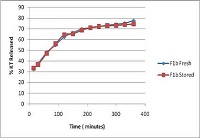Ketorolac Tromethamine In-situ Ocular Hydro Gel; Preparation, Characterization, and In-vivo Evaluation
Keywords:
Ketorolac Tromethamine, In situ gel, Chitosan, Corneal ulcer, Hydro gelAbstract
The aim of this work is to formulate Ketorolac tromethamine in a new ocular in situ hydro gel delivery system. Two polymers; Chitosan and Carbopol 940 were used in different concentrations for the preparation of the in situ hydro gels, all formulations exposed to visual examination, pH measurement, in-vitro release, rheological study, stability study, and in-vivo anti-inflammatory effect study on the inflamed eye of rabbits. Results showed that all formulations were clear and showed pH within the acceptable range, Chitosan 0.5%w/v gives the highest release rate, all formulae exhibited pseudoplastic flow with a thixotropic behavior, stability study showed that rate of drug degradation followed first order kinetics and 0.5% Chitosan based formula showed longer shelf life (2.532 year), the percent of unhealed ulcers of the inflamed eye of rabbits was 17.5% for 0.5% Chitosan in situ hydro gel compared to 55% for Acular eye drop (positive control). Statistical analysis of the data revealed significance difference between the tested formula and control solution at p <0.05. So this system that combines the advantages of both solutions and gels, such as accuracy and facility of administration of the former and prolonged residence time of the latter, also enhances the healing rate of Ketorolac tromethamine in ulcerative rabbit's eye compared to ocular eye drops.
References
Davies NM. Biopharmaceutical considerations in topical ocular drug delivery. Clin. Exp. Pharmacol. Physiol. 2000; 27: 558– 562.
Le Bourlais CL, Acar L, Zia H, Sado PA, Needham T and Leverge R.. Ophthalmic drug delivery systems—recent advances. Prog. Retin. Eye Res.
; 17: 35.
Kaur. IP and Kanwar M. Ocular preparations: the formulation approach. Drug Dev. Ind. Pharm. 2002; 28: 473–493.
Shell JW. Ophthalmic drug delivery systems. Surv. Ophthalmol.1984; 29:117.
Burstein NL and Anderson JA. Corneal penetration and ocular availability of drugs. J. Ocul. Pharmacol. 1985; 1: 309– 326.
Sirbat D, Marchal-Heussler L, Hoffman, M, and Maincent P. Ways to improve ocular bioavailability for topical applications. Ophthalmology. 2000; 23: 505–509.
Kaur IP and Smitha R. Penetration enhancers and ocular bioadhesives: two new avenues for ophthalmic drug delivery. Drug Dev. Ind. Pharm. 2002; 28: 353–369.
Schalnus R. Topical nonsteroidal anti-inflammatory therapy in ophthalmology. Ophthalmologiaca. 2003; 217:89–98.
Kokki H. Nonsteroidal anti-inflammatory drugs for postoperative pain: a focus on children. Paediatr. Drugs. 2003; 5:103–123.
Sweetman CS.; Martindale: The Complete Drug Reference. 34th ed. Pharmaceutical Press, London. 2005.
Malhotra M and Mujumdar DK. In vivo ocular availability of Ketorolac following ocular instillations of aqueous, oil, and ointment formulations to normal corneas of rabbits: A technical Note. AAPS Pharma sci tech. 2006; E1-E6.
Felt O, Baeyens V, Zignani M, Buri P and Gurny R. Mucosal drug delivery— ocular—Encyclopedia of controlled drug delivery. 1999; 2: 605–622.
Saettone MF, Giannaccini B, Guiducci A and Savigni P. Semisolid ophthalmic vehicles. III. An evaluation of four organic hydrogels containing pilocarpine. Int. J. Pharm. 1986; 31:261–270.
Ceulemans J, Vinckier I and Ludwig A. The use of xanthan gum in an ophthalmic liquid dosage form: rheological characterization of the interaction with muci. J. Pharm. Sci. 2002; 91: 1117–1127.
Yannic B, Schuetz l, Gurny R and Jordan O. A novel thermoresponsive hydrogel based on chitosan. Eur. J. Pharm. Biopharm. 2008; 68:19–25.
Carlfors J, Edsman K, Peterson R and Jornving K. Rheological evaluation of Gelrite in in situ gels for ophthalmic use. Eur. J. Pharm. Sci. 1998; 6: 113-119.
Chun IK, Kang JH and Gwak HS. Determination of ketorolac in human serum by high-performance liquid chromatography. Arch. Pharm. Res. 1996; 19: 529-534.
Ibrahim AA, Bosela AA, Ahmed SM and Mahrous GM. Proniosomes as a drug carrier for transdermal delivery of Ketorolac. Eur. J. Pharm. Biopharm. 2005; 59:485–490.
Bourlais CL, Acar L, Zia H, Sado PA., Needham T and Leverge R. Ophthalmic drug delivery systems—recent advances. Prog. Retin. Eye Res. 1998; 17:33–58.
Carsentensen JT. Drug stability, 2nd ed. Marcel Dekker. Inc. NewYork,
Basel, Hong Kong. 1995; 6-56.
Pharmacopoeia of the United States of America, 23rd ed. Mack Publishing Co. Pennsylvania. 1995; 1360-1364.
Le Bourlais CA, Treupel-Acar L, Rhodes CT, Sado PA and Leverge R. New ophthalmic drug delivery systems. Drug Dev. Ind. Pharm. 1995; 21:19.
Higushi WI. Analysis of data on medicament release from ointments. J. Pharm. Sci. 1962; 51: 802.
Doijad RC, Manvi FV and Malleswara Rao VS. Sustained ophthalmic delivery of gatifloxacin from In situ gelling system. Ind. Pharm. Sci. 2006; 68: 814-818.
Edsman K, Carlfors J and Harju K. Rheological evaluation and ocular contact time of some carbomers gels for ophthalmic use. Int. J. Pharm. 1996; 137: 233.
Padval MV and Bhargava HN. Liquid chromatographic determination of indapamide in the presence of its degradation products. J. Pharm. Biomed. Anal. 1993; 11:1033-1036.





